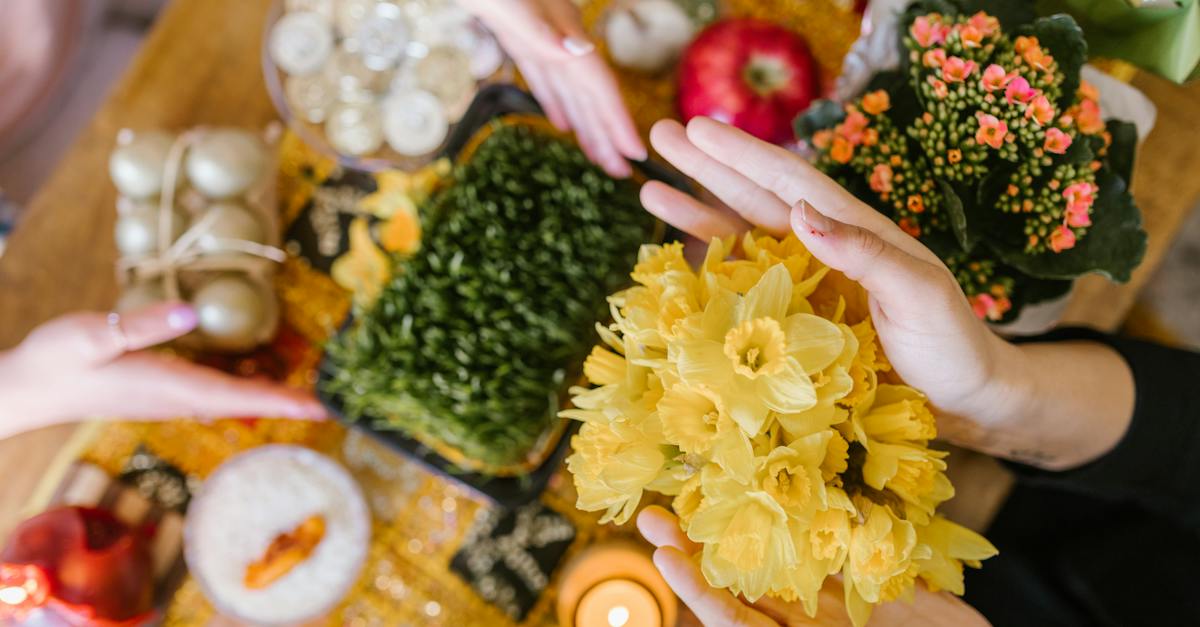As the New Year approaches, it’s time to embrace the festivities and traditions that come with it. And what better way to celebrate than with delicious traditional foods? In this article, I’ll take you on a culinary journey to explore the mouthwatering dishes that are a must-have for a Happy New Year 2024 celebration. From savory delicacies to sweet treats, these traditional foods are not only a feast for the taste buds but also steeped in cultural significance. So, get ready to tantalize your senses as we delve into the world of New Year’s culinary delights!
Contents
- 1 Traditional Food Preparations
- 2 Savory Delicacies for New Year
- 3 Sweet Treats to Ring in the New Year
- 4 Cultural Significance of New Year Foods
- 5 Conclusion
- 6 Frequently Asked Questions
- 6.1 Q: What is the significance of traditional New Year foods?
- 6.2 Q: What are some examples of traditional New Year foods?
- 6.3 Q: Why are black-eyed peas and collard greens important in the Southern United States?
- 6.4 Q: What is Tteokguk in Korean culture?
- 6.5 Q: What is the cultural influence of African and Southern culinary traditions in America?
Traditional Food Preparations
One of the most exciting aspects of celebrating the New Year is the preparation of traditional foods. As the countdown begins, households around the world gather in their kitchens to create culinary masterpieces that have been passed down through generations. These dishes not only bring families together but also carry deep cultural significance.
Here are a few traditional food preparations that you’ll want to try for a memorable Happy New Year 2024 celebration:
1. Black-Eyed Peas and Collard Greens: In Southern United States, it’s a tradition to serve black-eyed peas and collard greens on New Year’s Day. The black-eyed peas represent good luck, while the collard greens symbolize financial prosperity. Slow-cooked to perfection, these dishes are a delicious way to start the year on a positive note.
2. Tteokguk (Korean Rice Cake Soup): In Korean culture, families gather around the table to share a bowl of Tteokguk on New Year’s Day. This hearty soup is made with sliced rice cakes, beef broth, and various toppings. The long and cylindrical shape of the rice cakes symbolizes longevity and the passing of another year.
3. Hoppin’ John: Hoppin’ John is a classic Southern dish made with black-eyed peas, rice, and seasonings. It’s traditionally served on New Year’s Day in the United States as a symbol of good luck and prosperity. The peas represent coins, while the rice symbolizes wealth. Every spoonful is believed to bring a year of blessings and abundance.
4. Ozoni (Japanese New Year Soup): In Japan, Ozoni is a must-have dish for celebrating the New Year. This flavorful soup is made with a clear broth, vegetables, and mochi (rice cakes). The round shape of the mochi symbolizes harmony and good fortune. Each region in Japan has its own unique variation of Ozoni, making it a diverse and cherished tradition.
These traditional food preparations are more than just recipes. They represent a connection to our roots and the passing down of cultural heritage. So, as you plan your Happy New Year 2024 celebration, don’t forget to include these mouthwatering dishes that have been enjoyed for centuries.
Stay tuned as I continue to share more traditional New Year’s recipes and food customs to make your celebration truly special.
Savory Delicacies for New Year
As the New Year approaches, there’s no better way to celebrate than with a sumptuous feast. Traditional foods play a vital role in bringing joy and good fortune for the coming year. So, let’s take a closer look at some savory delicacies that you can include in your Happy New Year 2024 celebration:
Black-Eyed Peas and Collard Greens:
In the Southern United States, it’s a time-honored tradition to feast on black-eyed peas and collard greens. These dishes are believed to bring prosperity and good luck for the year ahead. The black-eyed peas symbolize coins, while the collard greens represent money. Together, they create a winning combination that promises financial success.
Tteokguk:
In Korean culture, Tteokguk, a traditional rice cake soup, takes center stage during New Year celebrations. The round shape and white color of the rice cakes symbolize fertility and purity, respectively. Tteokguk is not only a delicious treat but also signifies the idea of renewal and starting anew.
Hoppin’ John:
Hoppin’ John is a classic dish from the Southern United States that is often enjoyed on New Year’s Day. Made with black-eyed peas, rice, and flavorful seasonings, this dish is thought to bring good luck, wealth, and prosperity. Many believe that the more Hoppin’ John you eat, the more luck you’ll have throughout the year.
Ozoni:
In Japan, Ozoni is a traditional New Year’s dish that varies in ingredients depending on the region. It typically consists of a clear broth with mochi (rice cake), vegetables, and sometimes seafood. Ozoni represents happiness and good health in the coming year and is cherished as a special family meal during the New Year festivities.
These savory delicacies not only tantalize your taste buds but also embody the rich cultural heritage and symbolism associated with the New Year. Including these traditional dishes in your celebration will not only delight your guests but also create a deeper connection to your roots.
So, get ready to savor these exquisite dishes and embrace the traditions as you welcome the Happy New Year 2024.
Sweet Treats to Ring in the New Year
As we gather with our loved ones to celebrate the arrival of the New Year, it’s only fitting to indulge in some sweet treats to make the occasion even more joyful. These delectable delights hold a special place in our hearts and symbolize the sweetness and prosperity we hope to experience in the coming year.
1. Bubbly Champagne Cupcakes: What better way to toast to the New Year than with a champagne-infused cupcake? These moist and fluffy treats are topped with a luscious champagne buttercream frosting, adding a touch of elegance to your celebration. With each bite, you’ll taste the effervescence of the champagne, making it a perfect dessert to accompany the popping of champagne bottles at midnight.
2. Fortune Cookies: Originating from Chinese culture, fortune cookies have become a beloved treat worldwide. These crisp and golden cookies are often filled with a small slip of paper containing a message of good luck or wisdom. Breaking open a fortune cookie and reading the fortune inside is always an exciting and hopeful moment, making it a fun and interactive addition to your New Year’s spread.
3. Pomegranate Tart: Pomegranates are not only delicious but also hold symbolic meaning in many cultures. The vibrant red color represents prosperity and good fortune. A pomegranate tart with its buttery crust and tangy filling is a beautiful and flavorful dessert to include on your New Year’s menu. The burst of sweet and tart flavors will tantalize your taste buds and bring a touch of elegance to the table.
4. Zeppole: In Italian tradition, zeppole is a must-have treat for welcoming the New Year. These deep-fried dough balls are dusted with powdered sugar and often filled with sweet cream or custard. They are believed to bring good luck and abundance for the year ahead. Enjoying these warm and indulgent zeppole is a delightful way to honor your Italian heritage and satisfy your sweet tooth.
Cultural Significance of New Year Foods
New Year is a time of celebration and reflection, and in many cultures, food plays a central role in the festivities. Traditional New Year foods are not just delicious and satisfying, but they also hold deep cultural significance. These dishes are prepared with love and care, passed down through generations, and enjoyed together with family and friends. As we embrace the arrival of the year 2024, let’s explore the cultural significance of some of these mouthwatering dishes.
In Southern United States culture, the combination of black-eyed peas and collard greens is a staple New Year’s dish. Black-eyed peas represent good luck and prosperity, while collard greens symbolize money and wealth. Eating these foods on New Year’s Day is believed to bring good fortune throughout the year. The black-eyed peas are often cooked with ham hocks or bacon for added flavor, and the collard greens are typically simmered with onions and seasoned with salt and pepper. It’s a hearty and satisfying meal that brings families together to start the year on a positive note.
In Korean culture, Tteokguk, a traditional rice cake soup, is a must-have dish for New Year’s celebrations. Tteokguk is made with thinly sliced rice cakes, beef or chicken broth, and various toppings such as sliced eggs, beef, and vegetables. The long, cylindrical shape of the rice cakes symbolizes a long and prosperous life. It is believed that eating Tteokguk on New Year’s Day helps to ensure a year filled with good luck and blessings.
In the United States, particularly in the Southern states, Hoppin’ John is a popular New Year’s dish. This flavorful dish is a combination of black-eyed peas, rice, and bacon or ham hocks. It is often served with cornbread or collard greens. Hoppin’ John is believed to bring luck and good fortune in the coming year. The peas symbolize coins, the rice symbolizes wealth, and the pork represents progress. This dish showcases the influence of African and Southern culinary traditions in American culture.
Conclusion
Traditional New Year foods hold a deep cultural significance in various societies around the world. From the black-eyed peas and collard greens in the Southern United States to the Tteokguk in Korean culture, these dishes are more than just a meal. They symbolize good luck, prosperity, and wealth for the upcoming year.
The influence of African and Southern culinary traditions on American culture is evident through the popularity of dishes like Hoppin’ John. The blending of flavors and traditions has created a unique culinary landscape that celebrates diversity and heritage.
As we bid farewell to the old year and welcome the new, it’s important to honor and embrace these traditional foods. They not only provide nourishment for the body but also serve as a reminder of our roots and the values we hold dear.
So, as you gather around the table with loved ones to celebrate the New Year, remember the significance of these traditional foods. May they bring you good fortune, abundance, and a sense of connection to your cultural heritage. Here’s to a happy and prosperous New Year filled with delicious traditions!
Frequently Asked Questions
Q: What is the significance of traditional New Year foods?
A: Traditional New Year foods are believed to bring good luck and prosperity in the coming year.
Q: What are some examples of traditional New Year foods?
A: Examples include black-eyed peas and collard greens in the Southern United States, Tteokguk in Korean culture, and Hoppin’ John in the United States.
Q: Why are black-eyed peas and collard greens important in the Southern United States?
A: Black-eyed peas symbolize good luck and collard greens represent wealth in the New Year.
Q: What is Tteokguk in Korean culture?
A: Tteokguk is a dish made of sliced rice cakes and served in a flavorful broth. It is traditionally consumed on New Year’s Day in order to gain a year in age and receive blessings.
Q: What is the cultural influence of African and Southern culinary traditions in America?
A: African and Southern culinary traditions have greatly influenced American culture, as seen in the popularity of dishes like Hoppin’ John and the incorporation of collard greens and black-eyed peas in New Year celebrations.

